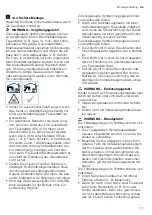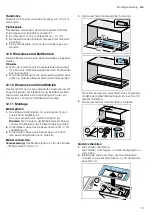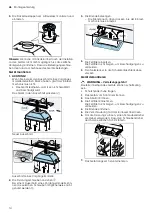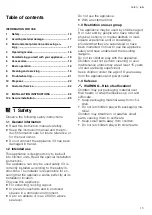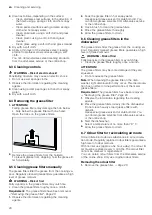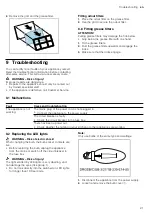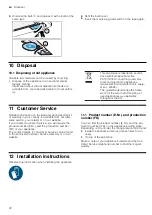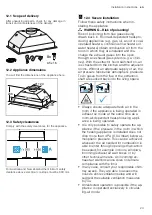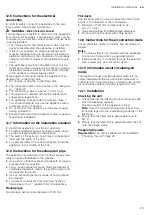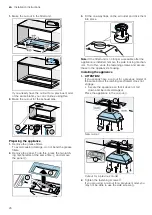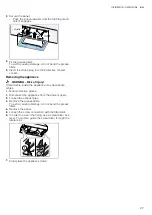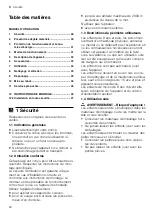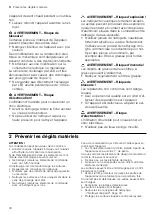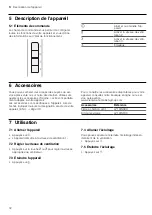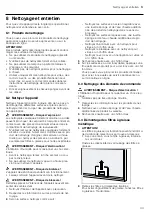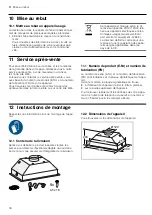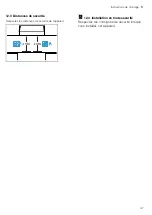
Installation instructions
en
25
12.6 Instructions for the electrical
connection
In order to safely connect the appliance to the elec-
trical system, follow these instructions.
WARNING ‒ Risk of electric shock!
It must always be possible to disconnect the appliance
from the electricity supply. The appliance must only be
connected to a protective contact socket that has been
correctly installed.
▶
The mains plug for the mains power cable must be
easily accessible after the appliance is installed.
▶
If this is not possible, an all-pole isolating switch
must be integrated into the permanent electrical in-
stallation according to the conditions of overvoltage
category III and according to the installation regula-
tions.
▶
The permanent electrical installation must only be
wired by a professional electrician. We recommend
installing a residual-current circuit breaker (RCCB)
in the appliance's power supply circuit.
Sharp-edged components inside the appliance may
damage the connecting cable.
▶
Do not kink or trap the connecting cable.
¡
The connection data can be found on the rating pla-
¡
The connecting cable is approx. 1.30 m long.
¡
This appliance complies with the EC interference
suppression regulations.
¡
The appliance corresponds to protection class 1.
You should therefore only use the appliance with a
protective earth connection.
¡
Do not connect the appliance to the power supply
during installation.
¡
Ensure that the protection against contact is guaran-
teed during installation.
12.7 Information on the installation situation
¡
Install this appliance in a kitchen cupboard.
¡
To install additional special accessory parts, obser-
ve the enclosed installation instructions.
¡
The width of the extractor hood must correspond at
least with the width of the hob.
¡
To optimally detect the cooking vapours, install the
appliance in the middle of the hob.
12.8 Instructions for the exhaust air pipe
The appliance manufacturer does not provide any war-
ranty for faults attributable to the pipeline.
¡
Use a short, straight exhaust air pipe with as large a
pipe diameter as possible.
¡
Long, rough exhaust air pipes, many pipe bends or
small pipe diameters reduce the suction power and
increase the fan noise.
¡
Use an exhaust pipe that is made of non-combusti-
ble material.
¡
To prevent condensate from returning, fit the ex-
haust pipe with a 1° gradient from the appliance.
Round pipes
Round pipes with an inner diameter of 120 mm.
Flat ducts
Use flat ducts with an inner cross-section that corres-
ponds to the diameter of the round pipes:
¡
Diameter of 120 mm corresponds to ap-
prox. 113 cm².
¡
Use sealing strips for different pipe diameters.
¡
Do not use any flat ducts with sharp bends.
12.9 Instructions for the air extraction mode
For air extraction mode, a one-way flap should be in-
stalled.
Notes
¡
If a one-way flap is not included with the appliance,
one can be ordered from a specialist retailer.
¡
If the exhaust air is conveyed through the external
wall, a telescopic duct should be used.
12.10 Information about circulating-air
mode
The appliance must only be operated when it is se-
curely installed and the air recirculation pipework is
connected. A connecting pipe or flexible hose and an
air recirculation diffuser are also required for this.
12.11 Installation
Checking the unit
1.
Check whether the fitted unit is level and has suffi-
cient load-bearing capacity.
The max. weight of the appliance is 5 kg.
Note:
Note the furniture manufacturer's specifica-
tions with regard to the load-bearing capacity of the
fitted unit.
2.
Ensure that the fitted unit is heat-resistant up to
90 °C.
3.
Ensure that the fitted unit is still stable after the cut-
outs have been made.
Preparing the units
Requirement:
The unit is suitable for the installation.

